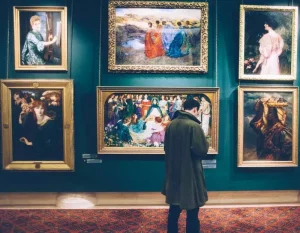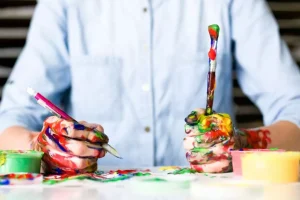There is more in common between art and yoga than meets the eye. Acquaintance with works of art and participation in their creation relieves stress, stimulates creative thinking and increases brain plasticity.
In addition, art is a great way to break out of the routine and look at events from an unexpected angle. The influence of art on the body is studied by neuroaesthetics and psychology. Here is what they say about how to “wash the dust of everyday life from the soul” with the help of the beautiful.
Art relieves stress
Creativity can benefit mental health. For example, even a single session of music therapy reduces anxiety in chronically ill patients, a 2016 Pennsylvania State University study found. During such a session, people listened to calm classical music with anxiety, and the electrical activity of their skin indicated that the level of stress after the therapy session decreased. A good classical concert will help even after a hard day’s work.

Art therapy helps people to be more calm about their illnesses. For example, patients with cancer and heart disease depict pain: art helps to express experiences that are difficult to put into words, accept your body and find new ways of expressing yourself.
The creative process is similar to meditation: it distracts from everyday worries, giving the brain a break from ordinary thoughts. Contact with works reduces stress levels by lowering levels of the hormone cortisol.
Art brings joy
In addition, art brings joy. When we learn new things, we get positive emotions – this is how the brain stimulates us to develop. That’s why it’s so important in art to create something unprecedented, whether it’s a painting of a black square or a performance featuring a coyote. And the brain, regardless of consciousness, tries to predict the final of different life situations. And, in the case of art, rejoices when the ending is unexpected. Therefore, a sharp turn of the plot in a play or an unusually finished stanza of a poem delights us on a subconscious level.
Art boosts empathy
We feel anxious when we look at Munch’s The Scream and weep when we see Titanic. That is, we try on other people’s reactions and achievements on ourselves. Mirror neurons help us do this: they are responsible for repeating movements and emotions. With the help of art, we can often experience a wider range of experiences than in ordinary life, which means we can learn to better understand others. Physicians, for example, are much more responsible when they are able to put themselves in the patient’s shoes and feel their pain.
Art makes us smarter
Every time you do something unusual or challenging, your brain creates new neural connections. This brain ability is called neuroplasticity, and creativity and exposure to art is one way to stimulate brain activity. For example, in the brain, fifty percent of the neurons are responsible for movement, so learning new ballet steps or learning guitar chords improves your memory. Take up pottery, origami or playing the piano – it will not only be pleasant, but also useful.
Neural networks are formed both during the collection and processing of new information. If you understand the painting of Gustav Klimt or the composition of “War and Peace”, and then discuss the topic or comprehend it in a post for social networks, your neural network will also develop.
How to make art a part of your life?
Integrating art into your daily life is not difficult, and you do not need to be an art historian to do so. Educational platforms that offer both classical lectures on painting, history and religious studies, as well as narrowly thematic lectures on the architectural styles of the Moscow metro or unusual gastronomic combinations will help you understand the beauty.

In addition, a new format has appeared: online and offline course guides on art, culture, architecture and science. Such courses are offered by Synchronization, an educational platform that tells about outstanding historical figures and trends in art, science and fashion in an interesting and accessible way. This is a great way to “change the conversation in the kitchen”: instead of gossip about mutual acquaintances or discussing routine matters, there are big ideas, good films, exhibitions and favorite books. Through these conversations, people get to know each other better and become closer.
Anyone can learn to understand architectural styles. And the lectures “What the pictures are silent about” or “Camera, motor: how cinema is made” will help you understand the secret intentions of great artists, learn how to watch movies correctly and enjoy the acquired knowledge in the most ordinary situations: while visiting a museum, walking around the city and watching a movie .
Art is everywhere, it affects us every day, whether we realize it or not. Painting, music, and even video can improve your mood, relieve anxiety, inspire you to solve difficult problems, and make you feel happier.
